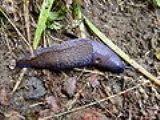
Bielzia coerulans
Encyclopedia
Bielzia coerulans, commonly known as the Carpathian blue slug or simply the blue slug, is a species
of very large land slug
, a terrestrial
pulmonate gastropod in the family
Limacidae
, the keelback slugs.
Bielzia coerulans is the only species in the genus Bielzia.
Some authors, for example Russian malacologists, classify genus Bielzia as the only genus (monotypic
) within separate family Limacopsidae Gerhardt, 1935. There has been also created separate subfamily Bielziinae I. M. Likharev & Wiktor, 1980 for genus Bielzia.
According to the taxonomy of Bouchet & Rocroi (2005)
are Limacopsidae and Bielziinae synonyms for Limacinae.
in Eastern Europe
.
The type locality of Bielzia coerulans is South Carpathians in Romania.
Juveniles are yellowish brown with dark lateral bands.
Reproductive system
: Genitalia are without penis. There is only an accessory organ for the copulation.
logs.
Maturity is in June to July. Copulation occur at the soil. There are 30-80 eggs laid in one clutch. Adults die after egg deposition. Half grown juveniles hibernate. Fully grown slugs appear in May.
Species
In biology, a species is one of the basic units of biological classification and a taxonomic rank. A species is often defined as a group of organisms capable of interbreeding and producing fertile offspring. While in many cases this definition is adequate, more precise or differing measures are...
of very large land slug
Slug
Slug is a common name that is normally applied to any gastropod mollusc that lacks a shell, has a very reduced shell, or has a small internal shell...
, a terrestrial
Terrestrial animal
Terrestrial animals are animals that live predominantly or entirely on land , as compared with aquatic animals, which live predominantly or entirely in the water , or amphibians, which rely on a combination of aquatic and terrestrial habitats...
pulmonate gastropod in the family
Family (biology)
In biological classification, family is* a taxonomic rank. Other well-known ranks are life, domain, kingdom, phylum, class, order, genus, and species, with family fitting between order and genus. As for the other well-known ranks, there is the option of an immediately lower rank, indicated by the...
Limacidae
Limacidae
Limacidae, common name the keelback slugs, are a taxonomic family of medium-sized to very large, air-breathing land slugs, terrestrial pulmonate gastropod molluscs in the superfamily Limacoidea.- Distribution :...
, the keelback slugs.
Taxonomy
Bielzia coerulans was discovered and described under name Limax coerulans by Austrian-Hungarian malacologist Michael Bielz (1787-1866) in 1851. (His son Eduard Albert Bielz was also malacologist.)Bielzia coerulans is the only species in the genus Bielzia.
Some authors, for example Russian malacologists, classify genus Bielzia as the only genus (monotypic
Monotypic
In biology, a monotypic taxon is a taxonomic group with only one biological type. The term's usage differs slightly between botany and zoology. The term monotypic has a separate use in conservation biology, monotypic habitat, regarding species habitat conversion eliminating biodiversity and...
) within separate family Limacopsidae Gerhardt, 1935. There has been also created separate subfamily Bielziinae I. M. Likharev & Wiktor, 1980 for genus Bielzia.
According to the taxonomy of Bouchet & Rocroi (2005)
Taxonomy of the Gastropoda (Bouchet & Rocroi, 2005)
The taxonomy of the Gastropoda as it was revised by Philippe Bouchet and Jean-Pierre Rocroi is currently the most up-to-date overall system for classifying gastropod mollusks...
are Limacopsidae and Bielziinae synonyms for Limacinae.
Distribution
This species is endemic to the Carpathian MountainsCarpathian Mountains
The Carpathian Mountains or Carpathians are a range of mountains forming an arc roughly long across Central and Eastern Europe, making them the second-longest mountain range in Europe...
in Eastern Europe
Eastern Europe
Eastern Europe is the eastern part of Europe. The term has widely disparate geopolitical, geographical, cultural and socioeconomic readings, which makes it highly context-dependent and even volatile, and there are "almost as many definitions of Eastern Europe as there are scholars of the region"...
.
The type locality of Bielzia coerulans is South Carpathians in Romania.
- Czech Republic - in Moravia only, vulnerable (VU) in Moravia
- southern Poland
- Slovakia
- Ukraine
- Romania
Description
This is a slug which is blue when adult and 100 - 140 mm in length. Slug evenly blue or bluish green (occasionally black) with dark greyish head and tentacles, margins pale yellowish, sole pale yellowish or whitish.Juveniles are yellowish brown with dark lateral bands.
Reproductive system
Reproductive system of gastropods
The reproductive system of gastropods varies greatly from one group to another within this very large and diverse taxonomic class of animals...
: Genitalia are without penis. There is only an accessory organ for the copulation.
Ecology
Bielzia coerulans inhabits deciduous and coniferous forests in mountains, usually at the bottom, or under dead woodDead wood
Forestry and gardening* coarse woody debris, fallen dead trees and the remains of large branches on the ground in forests.* large woody debris, logs, branches, and other wood that falls into streams and rivers....
logs.
Maturity is in June to July. Copulation occur at the soil. There are 30-80 eggs laid in one clutch. Adults die after egg deposition. Half grown juveniles hibernate. Fully grown slugs appear in May.

